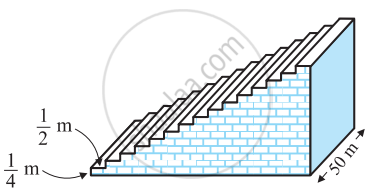Advertisements
Advertisements
प्रश्न
Sum of 1 to n natural numbers is 36, then find the value of n.
उत्तर
It is given that,
a = 1
d = 1
Sn = 36
Now,
\[S_n = \frac{n}{2}\left( 2a + \left( n - 1 \right)d \right)\]
\[ \Rightarrow 36 = \frac{n}{2}\left( 2\left( 1 \right) + \left( n - 1 \right)\left( 1 \right) \right)\]
\[ \Rightarrow 36 \times 2 = n\left( 2 + n - 1 \right)\]
\[ \Rightarrow 72 = n\left( n + 1 \right)\]
\[ \Rightarrow n^2 + n - 72 = 0\]
\[ \Rightarrow n^2 + 9n - 8n - 72 = 0\]
\[ \Rightarrow n\left( n + 9 \right) - 8\left( n + 9 \right) = 0\]
\[ \Rightarrow \left( n + 9 \right)\left( n - 8 \right) = 0\]
\[ \Rightarrow n = - 9\text { or n} = 8\]
\[ \Rightarrow n = 8 \left( \because n \neq - 9 \right)\]
Hence, the value of n is 8.
APPEARS IN
संबंधित प्रश्न
How many terms of the A.P. 18, 16, 14, .... be taken so that their sum is zero?
How many terms of the series 54, 51, 48, …. be taken so that their sum is 513 ? Explain the double answer
In an AP given d = 5, S9 = 75, find a and a9.
A small terrace at a football field comprises 15 steps, each of which is 50 m long and built of solid concrete. Each step has a rise of `1/4` m and a tread of `1/2` m (See figure). Calculate the total volume of concrete required to build the terrace.
[Hint: Volume of concrete required to build the first step = `1/4 xx 1/2 xx 50 m^3`]

Three numbers are in A.P. If the sum of these numbers is 27 and the product 648, find the numbers.
How many terms are there in the A.P. whose first and fifth terms are −14 and 2 respectively and the sum of the terms is 40?
If the 12th term of an A.P. is −13 and the sum of the first four terms is 24, what is the sum of first 10 terms?
If 10 times the 10th term of an AP is equal to 15 times the 15th term, show that its 25th term is zero.
How many numbers are there between 101 and 999, which are divisible by both 2 and 5?
The sum of three consecutive terms of an AP is 21 and the sum of the squares of these terms is 165. Find these terms
If the sum of a certain number of terms starting from first term of an A.P. is 25, 22, 19, ..., is 116. Find the last term.
Write the expression of the common difference of an A.P. whose first term is a and nth term is b.
The common difference of the A.P. is \[\frac{1}{2q}, \frac{1 - 2q}{2q}, \frac{1 - 4q}{2q}, . . .\] is
The 11th term and the 21st term of an A.P are 16 and 29 respectively, then find the first term, common difference and the 34th term.
Solve for x : 1 + 4 + 7 + 10 + … + x = 287.
The sum of first five multiples of 3 is ______.
Find the sum of first seven numbers which are multiples of 2 as well as of 9.
Find the sum of those integers between 1 and 500 which are multiples of 2 as well as of 5.
If the first term of an A.P. is p, second term is q and last term is r, then show that sum of all terms is `(q + r - 2p) xx ((p + r))/(2(q - p))`.
Which term of the Arithmetic Progression (A.P.) 15, 30, 45, 60...... is 300?
Hence find the sum of all the terms of the Arithmetic Progression (A.P.)
